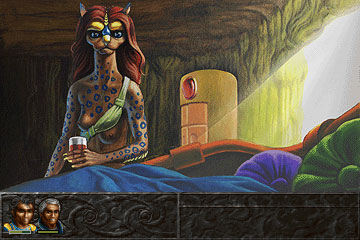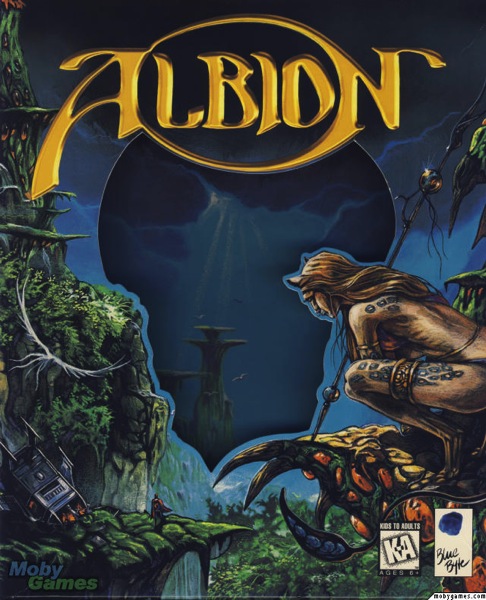Mainstream games, or at least a significant subset that I’m too lazy to define here, make use of three big techniques to tell stories:
- Cut-scenes.
- Invisible boxes.
- Environmental storytelling.
I think both game developers and players understand these techniques by now, and in fact I think players are getting tired of them. I know I am. And that means it is time to surprise people again, to innovate, by moving beyond these tools or by using them in new ways.
Cut-scenes
Cut-scenes are the most conventional and, perhaps not incidentally, also the most controversial tool. We’re splicing another medium, film, into our games. It is an effective medium to convey information and evoke emotion. Players and developers both understand cut-scenes, important reasons for their popularity. The effectiveness of cut-scenes balances out the fact that they are not interactive, and therefore tend to break immersion and take away agency. But it’s an uneasy balance. Cut-scenes, by definition, do not fit well in an interactive medium.
Over the last 20 years, innovation in cut-scenes has been about technology (how complex a scene can we show), production (how do we economically make more complex cut-scenes) and filmmaking craft (how do we make effective cut-scenes). There has been almost no innovation in the interactive aspects of cut-scenes, and this is to be expected since cut-scenes are pretty much defined by not being interactive.
(I classify dialogues as cut-scenes for the purpose of this article. How to do dialogue better or make it more interactive is beyond the scope of this blog post. People tried cool stuff in the 80s and early 90s, we did some reasonable things in the role-playing games I worked on, by now people have kinda stopped trying to invent new things, at least in AAA. I haven’t played enough Mass Effect or Skyrim to have an opinion on how they did, but I didn’t get the impression it was groundbreaking.)
Invisible boxes
Invisible boxes (or planes, spheres, volumes, etc.) are the tool that level designers use to trigger events. When you walk around a corner and a ceiling collapses, enemies come running towards you, or some characters act out a little scene (just out of your reach), then you just hit an invisible box. When you’ve seen them once, you see them everywhere.
And that is the problem. As a player, you develop a sense for these things. You know stepping into that big room or walking around the corner will trigger something, just as you know that if you just stay there, nothing is likely to happen, forever, except for the eerie and foreboding music. (The tendency for games to get stuck, when nothing happens because the player isn’t doing something, is a big immersion breaker.)
Invisible boxes are used to orchestrate events just so for the player’s enjoyment, to make sure she meets the right challenge at the right time, sees the right thing at the right moment. They are an easy tool to understand and to use, although hiding them requires finesse.
But they can never be fully hidden. At some point, the player realizes that the world arranges itself around her, and then the reality of being on a well-orchestrated ride dominates the illusion of being inside the fictional world of the game, and her behavior changes. She knows what to expect.
Invisible boxes are stupidly easy to implement, so there has been no innovation here for decades. We’ve become more sophisticated in how we use them, but the scripts in the games I wrote in the early 90s are conceptually the same as the scripts in current games.
Note also that invisible boxes are orthogonal to interactivity. We can use them to orchestrate spectacles, but they are not inherently interactive, they do not in themselves create or enable interesting choices for the player. In fact, they are often used to trigger or to artfully replace cut-scenes. Characters talk or interact in real time, scientists are drawn into ventilation shafts, but in such a way that the player doesn’t notice that she cannot interact with them.
Environmental storytelling
Environmental storytelling is telling a story through a game’s environment, specifically a story about what happened before you arrived in said environment. I believe the term was coined by Henry Jenkins, but I’m not an academic so I’m not going to research it. I first saw it used in System Shock. Remember finding those little cubby holes with a corpse and some empty food containers and recordings telling increasingly bleak tales of the bad stuff that happened before you arrived? Well, that was kind of the best use of that technique, and it’s been used more or less like that ever since. It was used well in Portal and Manhunt. It’s a useful technique, but limited. I recently saw a blog post critiquing the diaries and recordings in Bioshock 1 or 2. I surprisingly felt a bit disappointed at the start of Dishonored when early on, in the sewers, I found a little cubby hole with a corpse and some empty food containers and letters. I remember thinking “Oh no, it’s the 90s again.” For all I know it was a homage. Dishonored is great, you should play it.
So?
These three techniques have a number of things in common. They’ve been used a lot over the last 20 to 30 years, especially in ‘mainstream’ AAA games. Players understand how they work, they’ve learned the conventions. Developers understand how to use them, and have refined them over the years.
And there are signs that people are getting tired of them. I’ve got a whole different blog post on a back burner somewhere about techniques and gimmicks and genres. I don’t have an opinion why this is happening, whether people just get tired of any technique. Maybe they do. Maybe you can see this when you look at the evolution of TV and cinema and comics, how things are rebooted and reinterpreted. But I claim it’s happening.
Finally, none of these techniques are very interactive. Only invisible boxes can claim to be somewhat interactive, in the sense that they react to the player.
(Just a few days ago I read this profile of Mohammad Alavi in Edge:
Once more, Alavi charged into the wilderness alone, eventually writing over 10,000 lines of scripts that anticipated every way the player might disturb or be noticed by the patrolling soldiers, handling each case with different animations and behaviours. "It was crazy and jury-rigged together, but the end result is that you can enter the situation from any angle and it's legit — if they thought they saw you from a certain distance, they'd behave differently than if you popped up right in front of their face."
So maybe you can do some cool stuff with invisible boxes if you’re crazy. But they rewrote his scripts and turned it into proper AI.)
And I believe this shows that all of the current techniques we currently have are smoke and mirrors. Well-executed, cunningly used smoke and mirrors, perhaps. But we’ve taken things that we as developers understand and that our players understand, and have tacked them onto games. We’ve taught our players how to overlook the joins and seams, that we all know are there. And we’ve taken this as far as we can. Now the end is in sight. We’re close to not being able to do better, to not being able to afford to do more, and players have caught on to us.
We’re on a local maximum, a beautiful hilltop where things are great, but any movement leads downward. And that’s scary, because that means we have to leave behind what we built, pack a small backpack and trek through the wilderness to find new beauty. And we only have a vague idea of where to go. Some of us won’t make it.
I’ve been thinking about storytelling in games for a long time, since before I became a professional developer even. For years I chased immersion and used the techniques I described above. But I knew there had to be more. Now I am seeing hope, in games like FTL, in Spelunky, in Rebuild, in Dwarf Fortress, perhaps in Minecraft. It’s not the discovery of something blindingly new, but more suddenly looking at things in a different way. (And then seeing a trail leading from these games back in time to older games. It was there all along.) I don’t know where this trail will lead. I’m sure it will be different from where we were before. I can’t wait to find out.

